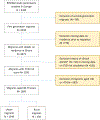Rural and urban migration to Europe in relation to cardiovascular disease risk: does it matter where you migrate from?
- PMID: 34233244
- PMCID: PMC8349844
- DOI: 10.1016/j.puhe.2021.06.001
Rural and urban migration to Europe in relation to cardiovascular disease risk: does it matter where you migrate from?
Abstract
Objectives: To assess whether the environmental context (i.e. rural vs urban) in which individuals in low- and middle-income countries have resided most of their lives is associated with estimated cardiovascular disease (CVD) risk after migration to a high-income country.
Study design: Data from the Research on Obesity and Diabetes among African Migrants (RODAM) study were used including 1699 Ghanaian participants aged 40-79 years who had migrated to Europe from Ghana (1549 of urban origin, 150 of rural origin).
Methods: Ten-year CVD risk was estimated using the Pooled Cohort Equation, with estimates ≥7.5% defining elevated CVD risk. Comparisons between urban and rural origin migrant groups were made using proportions and adjusted odds ratios (ORs).
Results: The proportion of migrants with an elevated CVD-risk score was substantially higher among rural migrants than among urban migrants (45% vs. 37%, OR = 1.44, 95% confidence interval [CI]:1.03-2.02), which persisted after adjustment for education level, site of residence in Europe (London, Amsterdam or Berlin), length of stay in Europe, physical activity, energy intake and alcohol consumption (OR = 1.67, 95% CI: 1.05-2.67).
Conclusion: Our findings indicate that migrants who spent most of their lives in a rural setting before migration to Europe may have a higher CVD risk than those of urban origins. Further work is needed to confirm these findings in other migrant populations and to unravel the mechanisms driving the differential CVD risk between urban and rural migrants.
Keywords: Africans; Cardiovascular risk; Migrants; RODAM study.
Published by Elsevier Ltd.
Conflict of interest statement
Conflict of interests
The authors declare that they have no competing interests.
Figures
References
-
- Zhou B, Bentham J, Di Cesare M, Bixby H, Danaei G, Cowan MJ, Paciorek CJ, Singh G, Hajifathalian K, Bennett JE. Worldwide trends in blood pressure from 1975 to 2015: a pooled analysis of 1479 population-based measurement studies with 19· 1 million participants. The Lancet. 2017; 389:37–55. - PMC - PubMed
-
- World Health Organization. 2008–2013 Action Plan for the Global Strategy for the Prevention and Control of Noncommunicable Diseases. Geneva: WHO; 2008.
-
- Agyemang C, Kieft S, Snijder MB, Beune EJ, van den Born B-J, Brewster LM, Ujcic-Voortman JJ, Bindraban N, van Montfrans G, Peters RJ. Hypertension control in a large multi-ethnic cohort in Amsterdam, The Netherlands: the HELIUS study. International journal of cardiology. 2015; 183:180–9. - PubMed
MeSH terms
Grants and funding
LinkOut - more resources
Full Text Sources


